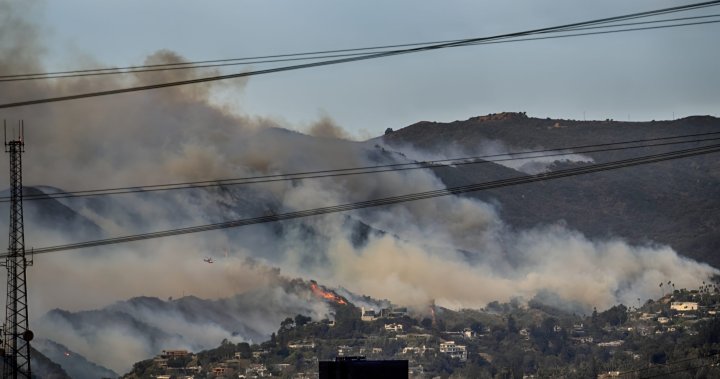The devastating wildfires sweeping through Los Angeles County in late 2025 painted a grim picture of destruction, forcing residents to flee their homes under a smoke-filled sky. Lindsay Rupp, a Canadian-born mother of two, described the scene as apocalyptic as she made a hasty retreat from her Brentwood neighborhood. The normally bustling streets were eerily silent, resembling a ghost town at 9 a.m., with the ominous glow of flames visible on the horizon. Rupp frantically gathered essential belongings for herself and her children, stuffing them into garbage bags before the escape route closed. She knew that time was of the essence as the fire rapidly advanced towards her community. The experience was deeply unsettling, leaving Rupp with a sense of dread and uncertainty about the fate of her home.
Rupp’s story is just one of many emerging from the fire-ravaged region. Multiple fires erupted across Los Angeles, fueled by extreme drought conditions and propelled by ferocious winds, making containment efforts incredibly challenging for firefighters. Thousands of structures were reduced to ashes, and tens of thousands of residents were displaced, seeking refuge with friends, family, or in temporary shelters. Rupp herself found shelter with friends, while her children stayed with their father in a safe location. The emotional toll of the disaster was immense, as Rupp learned of numerous friends who lost their homes, including six in her immediate neighborhood. Pictures from neighbors depicted flames just yards away from her own house, adding to the agonizing uncertainty.
The devastation extended beyond residential areas, impacting entire communities. Rupp described the Palisades neighborhood, where some of her friends lived, as virtually obliterated. Homes, schools, and even the sports fields where her children once played were all consumed by the flames. The scope of the destruction was truly heartbreaking. Dr. Martha Gulati, a cardiologist originally from London, Ontario, was also forced to evacuate her home near Runyon Canyon in the Hollywood Hills, a location precariously positioned between two major fires. She described the typically sunny Los Angeles sky as choked with smoke, creating a frightening and unsettling atmosphere.
The impact of the fires extended far beyond the immediate area. At Vancouver International Airport, arriving passengers from Los Angeles recounted their harrowing experiences escaping the inferno. Dawn Marie Stager, a resident of Upland, California, described the drive to LAX as “Armageddon-ish,” with darkness and smoke pervading the air. Her husband, Tim Stager, a lifelong resident of the area, confirmed that it was the worst fire situation they had ever witnessed. Ilana Gory, a tourist from Australia, witnessed the stark transformation of the Los Angeles landscape from “beautiful, sunny skies” to an oppressive blackness. Her hotel lobby in Santa Monica was overflowing with evacuees from the Palisades, faces etched with fear and worry. Even during takeoff, the burning fires were clearly visible, a stark reminder of the ongoing disaster.
Amid the chaos and devastation, stories of resilience and community support emerged. Rupp expressed gratitude for the outpouring of help from neighbors, friends, and even strangers. Offers of clothing for her children, the establishment of a temporary camp for displaced children, and the provision of medication refills by local drugstores provided a glimmer of hope in a dark time. These acts of kindness, however small, helped to mitigate the horrific nature of the disaster and fostered a sense of community in the face of adversity. The selfless dedication of the firefighters and emergency workers, who risked their lives to save homes and protect residents, also drew immense praise. Rupp expressed deep gratitude for their unwavering commitment, acknowledging the immense challenges they faced in battling the relentless flames.
The 2025 Los Angeles wildfires served as a stark reminder of the destructive power of nature, exacerbated by climate change and drought conditions. The fires left an indelible mark on the landscape and the lives of countless individuals, forcing them to confront loss, displacement, and uncertainty. However, amidst the devastation, the strength of the human spirit shone through, as communities rallied together to support one another, offering help, comfort, and a shared sense of resilience in the face of an unprecedented disaster. The experience underscored the importance of preparedness, community support, and the unwavering dedication of first responders in mitigating the impact of such catastrophic events.

